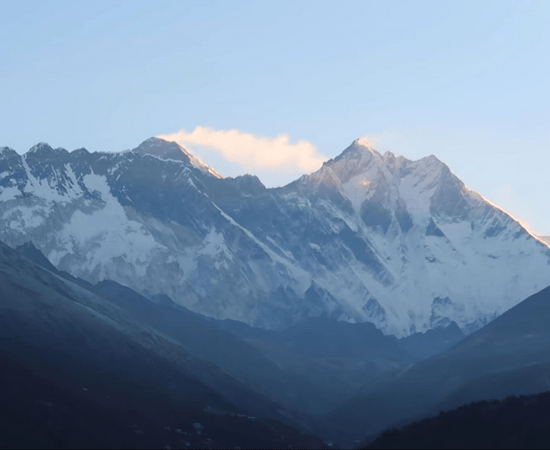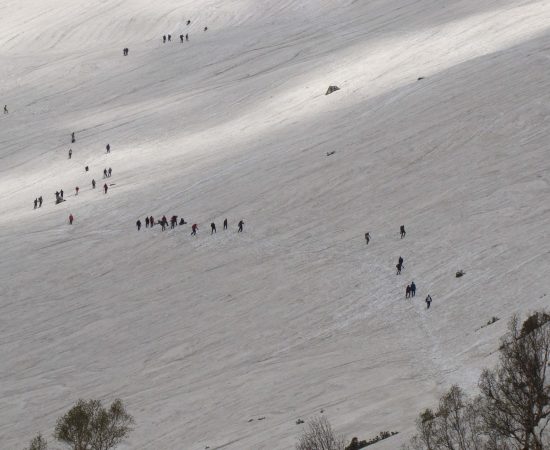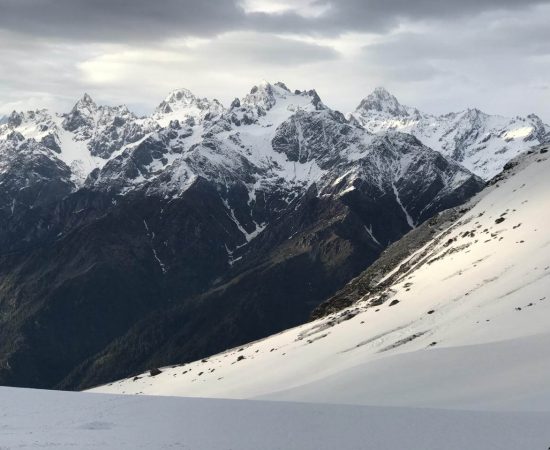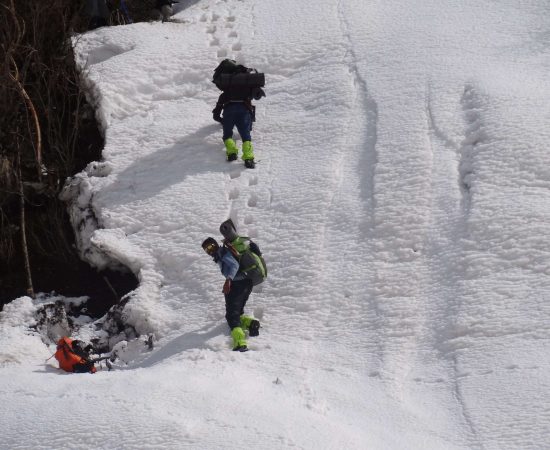Har Ki Dun Trek
Sankri, Uttarakhand
Rated 4.9/5.0 on TripAdvisor. 550 Reviews


Key Highlights
- Altitude : 3500mts
- Time : 7 Days - 6 Nights
- Region: Uttarakhand
- Best Time: March, April, May, September
- Distance: 34Kms
- Grade: Easy
Overview
Har Ki Dun Trek
Har ki Dun, also known as the valley of Gods, is one of the most beautiful treks in the nation and is situated in the Garhwal Himalayas of the Uttarkashi district. Due to its location in the Govind Pashu Vihar National Park, the trek offers a wide variety of diverse flora and fauna. If you're fortunate, you might even get to see some wildlife, including pheasants, chukars, bearded vultures, black eagles, gold eagles, himalayan snowcocks, monals, and many other species. While you are on the walk, you may see many more creatures in addition to birds, such as the Snow Leopard, Himalayan Black Bear, Brown Bear, Tahr, Serow, Bharal, Musk Deer, etc. Since there are no roads connecting these villages, residents must trek to the roadhead in order to get supplies or even go to school. The trek begins in the charming little village of Taluka, and throughout its easy to moderate length, you will see more villages like Taluka that are completely cut off from civilization. Enjoy the distinctive culture and folklore of the inhabitants as they share with you the unique offerings of each and every town in this valley. The trip follows the Supin River and offers breathtaking views of significant Himalayan peaks including Black Peak/Kalanag and Swargarohini. Because of its fabled tales, this river valley is also known as the valley of the gods. It is said that the Pandavas from the Mahabharata travelled along this same path to reach their heavenly home. a real refuge for hikers of all stripes with a mysterious tale to support it.
Cost Per Person
Key Highlights
- Altitude : 3500 mts.
- Time : 7 Days - 6 Nights
- Region: Uttarakhand
- Best Time: March, April, May, September
- Distance: 67Kms
- Grade: Easy
Complete
Itinerary of trek
Sankri, the starting point for the Har ki Dun walk, is roughly 200 kilometres (hours) from Dehradun. Your trek leader will meet you when you arrive in Sankri and assist you in checking into your homestay or guest house. The Trek Leader will hold a session where you will be instructed on all of the trek's requirements once you have had time to freshen yourself after the long trip from Dehradun. Eat supper and get plenty of rest before the hike starts the next day. Stay the night at a homestay or guest house in Sankri.
We'll have breakfast at the Sankri Homestay/Guest House and bring a packed lunch for the trip. We will get in our car and go to Taluka, where our hike will start. Due to the narrow and sometimes damaged road, it takes roughly an hour to travel the 12 kilometres to Taluka from Sankri. From Taluka, we descend to the Supin River's banks and continue on the route that runs beside the river. Har Ki Dun Trek gives a beautiful view of the river and the surrounding woodlands from the very beginning. The track is generally level in the beginning, with a few uphills and downhills to keep you interested and lovely scenery to accompany you. We will begin our ascent after a couple of hours of hiking. From this point on, the route will primarily be steep, and you will have to zigzag your way up the mountain. We will also pass the hamlet of Gangadh on the route to Seematra, which is on our left. The first campground, Seema, is just another hour away from Gangadh. Since the campground is so close to the river, you can even hear the water rushing while you sleep. Stay the night at the Seema campground.
We will go on to our next campsite, Kalkatiyadhar, after some warm-up exercises and breakfast at the campground. We set off on foot in a generally level area until we arrive at the iron bridge at Seema, which we will use to cross the Supin River. The hard slope starts after that. The track may be seen zigzagging beside the mountain. We travel this difficult way and ascend the mountain to arrive at a huge pasture. We can see the settlement of Osla as we ascend the zigzag trail, but we must get to our campground so we will follow the correct path. We will quickly arrive at our camping location in Kalkatiyadhar. Spend the remaining time relaxing and recharging your muscles before the longest and hardest day of the week.
The hardest and longest day of the walk is today, so get up as early as you can to prepare. Before leaving at precisely six in the morning for our trip, we'll enjoy a short and simple breakfast. We will start our adventure by climbing Seematra at a 45-degree angle. The extensive grassland continues to this point. The Supin Water and the river flowing from the Ruinsara Valley meet here, as well. As the trip continues, admire the natural splendour of the valley. From this point on, the magnificent Har ki Dun mountain and Black Peak from Ruinsara valley serve as our guides. The route meanders over the contours of the mountain before entering a deep oak and pine forest. On the way, we'll even see a few waterfalls. The last section of the Har ki Dun route runs next to the Supin River before you approach the valley of Har ki Dun. This will be our trek's pinnacle when we arrive at the foot of the Har khi Dun mountain. From here, you can see Jaundhar Glacier to your right and a route leading to Marinda Lake, an alpine lake, to your left. We follow the same way back to our tent at Kalkatiyadhar after spending some time in the valley and eating our packed lunch.
After a well-earned break in the Har ki Dun valley after the frantic summit day, we will start our return trip. We'll go over the same grasslands as we did to get to our campground, but this time, rather of going backwards and seeing the settlement of Osla, we'll move ahead. You may see the way of life of the natives here and the amount of labour they put in on a daily basis. The village temple in Osla village, with its distinctive style, is the main draw. We will spend some time in the hamlet before starting the descent to Pauni Garaat, where we will set up camp for the night. The Garaat hydraulic mill in Uttarakhand has been used by the villagers to grind wheat into flour for ages. Many of these mills may be seen on the road to Pauni Garaat.
We will start our drive back to the roadhead after eating breakfast at our campground in Pauni Garaat. If there was anything you missed when visiting Har Ki Dun Valley, here is your opportunity to see it all again since we'll be returning by the same path. On the way back, we'll see Gangadh settlement as well as the extensive oak and pine woods we passed through en route. It's a great chance to look back on all the memories we had on the walk. Our van will be waiting for us when we get in Taluka so we can go back to Sankri. As soon as we get to Sankri, we check into our homestay or guest house. Get dressed up and celebrate your successful voyage.
After breakfast, we'll bid Sankri farewell and board the cars that will drive us back to Dehradun's modern world.
Enquiry For Group Bookings
Guidelines
➽ Preparation for Trek
As you well know, the great Himalayan trek is one that requires careful preparation, a strategy that allows for enough flexibility to adapt to whatever challenges may arise.
Therefore, here are some things to consider before setting out on your trek:
⦿ Physically – You should start working out at least a month before signing up for a program if you want to be physically prepared for the rigours of a journey. Strengthen your legs by jogging and working out regularly to increase your stamina. To better acclimatise to the environment and increase your resilience on the walk, you should give up smoking and undertake breathing exercises twice a day. Engage in vigorous physical activity, such as playing sports, doing Yoga, or running.
⦿ Mentally –
Getting in shape physically is essential, but mental preparation is just as crucial for a successful walk. Take time to enjoy your regular activities, maintain a healthy diet and sleep schedule, and unwind before embarking on a hike. Predictions regarding the journey should not cause mental worry. Spend time with your closest pals to recharge your batteries and renew your spirit. Pre-trek preconceptions are unwarranted since the first contact with the other trekkers is certain to be a source of inspiration and energy. Conditions during the walk will contribute to the increase in mental readiness. The mental repercussions of physical disadvantages will not be ignored. So, when you hike, pay attention to different regions of your body and purposefully relax them. If you want to enjoy your hike, you should learn to loosen up a little, particularly in the hips. Think about your descent as a simple dance, and enjoy the natural rhythms that the path and your body can discover together gradually, whether you're on a flowing downhill route or a frightening slope. Try out a few new walking techniques to add some fun to your commute without worrying about getting somewhere in particular. Maintaining mental fitness mostly requires a willingness to relax and take in the journey, rather than subjecting oneself to undue stress.
⦿ Technically-
Get the right size hiking boots and go for it, from a technical standpoint. You should make use of 60 litres. To become acclimated to carrying heavy items, it is recommended to utilise a backpack on a regular basis. Get a hiking stick, a water bottle, some thermal socks, a fleece or feather coat, some long pants, a poncho, some flip-flops, and any devices you may need like a camera or a power bank (DSLR or digital camera).
Guidelines
➽ Things to Carry
- Good Trekking Boots: You need sturdy trekking boots with supportive high ankles. Don't bring your running shoes. U can carry extra floaters/flip flops also.
- Wear warm clothing, such three-layer coats, fleece upper, hollow fill or down-filled jackets. Carry full-sleeved T-shirt. Carry cotton hiking trek pants and warm pant for your lower body. Never bring shorts or jeans on a hike.
- Take top and bottom thermals with you.
- Quick dry towel with light weight and Personal toiletries. Suns cream lotion, sanitizer, tooth brush ad toothpaste, lip balm and antibacterial powder.
- Socks: Bring two pairs of regular socks and two pair of wool socks for wearing at night.
- A head torch is required.
- Sunglasses/ Goggle: UV-protected sunglasses are necessary to protect against sunlight and Snow Mountain.
- There should also be a woolen cap / balaclava, cap, neck gaiter cum face mask and warm fleece and waterproof summit gloves since it will be chilly. Keep waterproof gloves on hand since they become wet in the snow.
- Everyone taking part in the activity should have their own lunchbox, spoon, mug and water bottle/ hydration pack of 2 ltr.
- Raincoats/ponchos: Since snowfall and rain are frequent at high elevations, it is important to have one on hand so as to avoid getting wet.
- Trekking bag of 75 ltr with rain cover.
- Walking stik.
- Electronics: camera (optional) USB cable/USB solar charger, charger/earphones, Power bank fully charged.
- Personal first aid box. Emergency ration, energy bars, dry fruit, electoral/Ors
- Required Documents:
a) Registration Form
b) Medical Certificate (signed by a licensed MBBS physician)
c) NOC form (completed by the trekker)
d) 2 passport-size photos
e) ID Proof photo (not PAN)
g) Insurance upto 5 lac..
Guidelines
➽ How to Reach
Distance by road:-
Dehradun has excellent road connections to the rest of the country. Dehradun is linked to Nahan, 95 kilometres (km) to the north-west, and from Nahan to Panchkula, Chandigarh, and Shimla by NH72. Haridwar is the last stop on NH 72, and it's just 54 kilometres from Dehradun. From Delhi, Dehradun is 235 kilometres away. Dehra Dunk connects to Roorkee via NH58 (67 km), which leads south to Meerut (170 km) and Delhi (235 km). Delhi ISBT Kashmere Gate is where you can get a bus to Dehradun.
Location of the Closest Train Station:-
Dehradun is well-connected to other major cities in India through train, including Delhi, Mussoorie, Mumbai, Varanasi, Lucknow, and Kolkata. DDN NZM AC EXPRESS DEPARTING FROM DELHI (2205)
Term referring to the closest airport:-
About 25 kilometres outside of Dehradun lies Jolly Grant Airport, the city's primary airport. From Delhi, you may take a daily flight to Dehradun.
➽ Trip Cost Includes
- Conveyance within the journey.
- Tents that can be shared.
- Advanced and knowledgeable himalayan adventure trips guide.
- Cooks, helpers, and other necessary personnel.
- Vegetarian meals (breakfast, lunch, and dinner) along the journey
- Every organisational prerequisite for a journey
- First aid kit with portal oxygen.
- Camping fees and forest permits.
- All permissions for hiking.
- All meals will be supplied while on the hike. Freshly cooked meals will include a mix of indian, chinese, and continental cuisines.
- Lodging at a hotel, guest house, home, or in tents.
- All of the group's trekking equipment (tents at base camp, use of base camp facilities)
- All trip workers, including porters and mules for everyday items (such as food, tents, and utensils)
➽ Trip cost Excludes
- Airfare or other forms of transportation costs.
- Meals and hotel accommodations.
- Personal costs include washing, cell charging, and lodge showers
- Entry permits or permission for the inner line for foreign participants.
- Personal apparel and hiking supplies, such as liners for sleeping bags and walking sticks, are required.
- Any expenditures associated with rescue efforts or an early expedition departure.
- Guides and sherpa crew are tipped.
- Personal porters to carry hikers' packs
- Personal liability insurance or emergency evacuation costs
- Personal purchases (such as bottles of mineral water, bottled or canned drinks, chocolate, dried fruit, presents, etc.).
- From and to the trailhead, food.
- 5% goods and service tax (gst).
Guidelines
➽ Special Casual Leaves
Government employee can avail the benefit of special casual leave when u join us for a trekking expedition. As per the rule of the pay commission, special casual leave can be availed for up to 30 days in a calendar years for trekking and mountaineering expeditions through a register organization. Himalayan adventure trips are a register adventure tour operator register with Indian mountaineering foundation and Himachal Pradesh tourism. Candidates have to apply for leave at least 30 days before the trek/expedition start.
Testimonials
➽ Provided By The Customers
Everything about our visit to Prashar lake was better than we could have imagined. From our initial contact with Himalayan Adventure Trips, we felt their genuine interest in learning about our group's goals and expectations, and our travels with them reinforced at every turn that they not only understood our requirements but also have the acute skill and expertise to achieve them. Having already had such a wonderful experience with this firm, I will be promoting a trek to Prashar lake to all my friends who share my passion for hiking and will specifically recommend that they work with this outfit. Absolutely fantastic; I have nothing but praise for it.
How useful was this post?
Click on a star to rate it!
Average rating 0 / 5. Vote count: 0
No votes so far! Be the first to rate this post.







